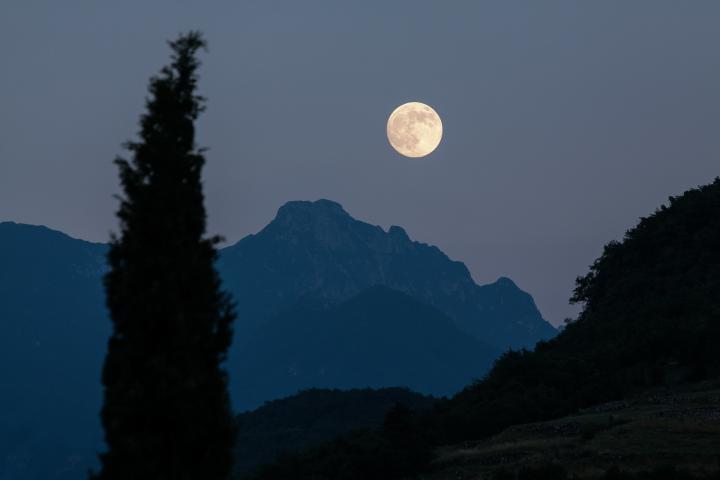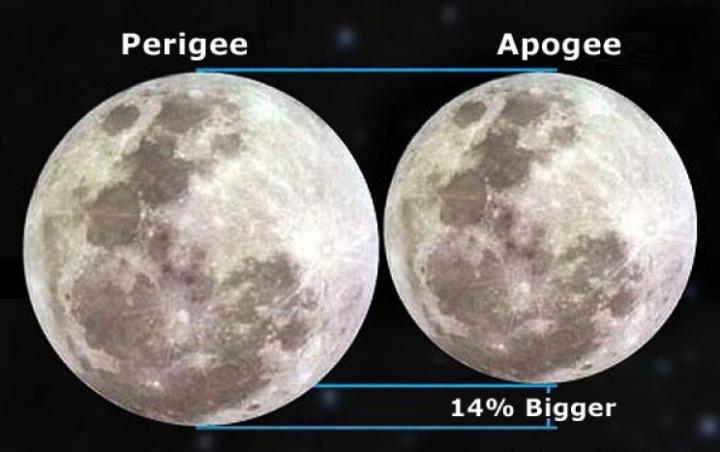In 2025, we will have THREE supermoons in a row! October brings us the year’s first supermoon; then, we will see one in November and December! What is a supermoon, exactly? We agree that it’s a catchy word—and anything encouraging us to explore the night sky is positive—but let’s also get our facts straight.
What Is a Supermoon?
Generally speaking, a supermoon is a full Moon that appears larger than a typical full Moon because it is closer to Earth.
However, there’s a bit more to it than that! In fact, there are a couple of definitions of “supermoon” out there. Let’s go through the two most popular ones, which we’ll refer to as the “broad” definition and the “strict” definition:
- Broad Definition: A supermoon is a new or full Moon that occurs when the Moon is near perigee (the point in the Moon’s orbit where it is closest to Earth). By this definition, there can be several supermoons in a year. The term, “supermoon,” was coined by astrologer Richard Nolle in 1979, who specified that the Moon must be within 90% of perigee.
- Strict Definition: A supermoon is the single closest new Moon and full Moon of the year. By this definition, there can be only two supermoons each year (a full Moon supermoon and a new Moon supermoon).
In popular usage, most folks go by the broad definition since it’s much more exciting to talk about multiple supermoons instead of just one or two. Plus, “supermoon” tends to refer only to full Moons rather than both full and new Moons. (This makes sense, given that new Moons are essentially invisible from Earth.)
How Many Supermoons Are There in 2025?
Different publications use slightly different thresholds for deciding which full Moons qualify as supermoons, but here at The Old Farmer’s Almanac, we follow the broad definition described above.
According to this definition, in 2025, the full Moons of October, November, and December all qualify as supermoons—reaching 90% of perigee, the Moon’s closest approach to Earth.
Next year, 2026, will bring us 3 supermoons, with full supermoons on January 3, 2026; November 24, 2026; and December 23, 2026.
Supermoons in 2025| Name | Date | Distance from Earth |
|---|
| Full Harvest Moon | October 6, at 11:47 P.M. EDT | 224,600 miles (361,458 kilometers) |
| Full Beaver Moon* | November 5 at 8:19 A.M. EST | 221,817 miles (356,980 kilometers) |
| Full Cold Moon | December 4 at 6:14 P.M. EST | 221,965 miles (357,219 kilometers) |
Perigee distance data by Fred Espenak, www.Astropixels.com.
*Indicates the closest supermoon of the year. |

Why Do Supermoons Occur?
It all comes down to the fact that the Moon’s orbit around Earth is not a perfect circle— it’s an elliptical (oval) shape.
Because of this, the Moon’s distance from Earth changes as it travels around our planet. Additionally, Earth doesn’t sit directly in the middle of this elliptical orbit, so there are points in the Moon’s orbit where it is closest and farthest from Earth. These points are called perigee and apogee, respectively.
- Perigee is the point in the Moon’s orbit where it is closest to Earth.
- Apogee is the point in the Moon’s orbit where it is farthest from Earth.
The Moon makes one complete orbit around Earth in about 29.53 days, which means it reaches its perigee and apogee points about once a month. When this occurs simultaneously as a full Moon, it’s called a perigee-syzygy—or, more commonly, a supermoon!
- ”Syzygy” is the astronomical term for when three or more celestial bodies (such as the Sun, the Moon, and Earth) line up. When the Sun, Earth, and Moon form a syzygy, we experience a full or new Moon, depending on whether the Moon is between the Sun and Earth or Earth is between the Sun and the Moon.
Where Did the Term “Supermoon” Come From?
Although it has been all over the news in recent years, “supermoon” is not an official astronomical term. In fact, it didn’t even exist until astrologer Richard Nolle used it in 1979!
At the time, Nolle defined a supermoon as “a new or full Moon which occurs with the Moon at or near (within 90% of) its closest approach to Earth in a given orbit.” Most people follow this definition today, though we tend to pay attention only to the full Moon supermoons, since they’re a lot more interesting to look at!
Does a Supermoon Really Look Bigger?
Given that a full Moon supermoon is closer to Earth than a typical full Moon, it does appear larger—about 7% larger, technically speaking. This means that the difference between a full Moon at perigee and a full Moon at apogee can be up to 14%, which is significant.

Here’s the critical fact, however: Unless you were somehow able to compare a normal full Moon and a supermoon side by side in the sky, it’s nearly impossible to perceive a 7% difference in the Moon’s size.
Even if you could somehow place the year’s biggest possible Moon (the perigee full Moon) next to the smallest one (an apogee full Moon) in the sky, you’d just barely tell the difference. And that’s with the absolute extreme Moons!
The bottom line is that it’s difficult to truly perceive any difference in the Moon’s size from one month to the next or one night to the next, so don’t get your hopes up about seeing a gigantic Moon out there.
The Moon Illusion
If you want to be guaranteed to see a huge-looking Moon, it’s easy… Simply watch the Moon when it’s rising or setting!
A Moon down near the horizon will always look enormous, thanks to a well-known phenomenon called the Moon illusion, which makes our minds exaggerate the size of objects near the skyline.
Try it! If you want a truly massive supermoon, you can have it—any night!












